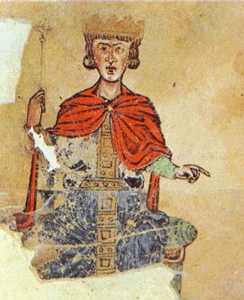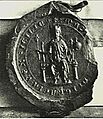Manfred, King of Sicily facts for kids
Quick facts for kids Manfred |
|
|---|---|

Contemporary depiction of Manfred from the De arte venandi cum avibus - Vatican Library ms. pal. lat. 1071 , fol. 1v (13th-century)
|
|
| King of Sicily | |
| Reign | 1258 – 26 February 1266 |
| Coronation | 10 August 1258 |
| Predecessor | Conradin |
| Successor | Charles I |
| Born | Manfred Lancia 1232 Venosa, Kingdom of Sicily |
| Died | 26 February 1266 (aged 34) Benevento, Kingdom of Sicily |
| Spouse |
Beatrice of Savoy
(m. 1247; died 1259)Helena Angelina Doukaina
(m. 1259) |
| Issue | Constance, Queen of Sicily Beatrix Henry Anselm Frederick (illeg.) Flordelis |
| House | Hohenstaufen |
| Father | Frederick II, Holy Roman Emperor |
| Mother | Bianca Lancia |
Manfred (Sicilian: Manfredi di Sicilia; 1232 – 26 February 1266) was the last King of Sicily from the Hohenstaufen family. He ruled from 1258 until his death. Manfred was the son of the powerful Holy Roman Emperor Frederick II.
In 1254, Manfred became a regent (someone who rules for a king who is too young or unable to rule). He ruled the Kingdom of Sicily for his young nephew, Conradin. As regent, he put down many rebellions. But in 1258, he took the throne for himself.
Manfred tried to make peace with Pope Innocent IV at first. However, he soon continued the fight between his family (the Hohenstaufens) and the Pope. He won a big battle against the Pope's army at Foggia in 1254. Three different Popes later excommunicated him, which meant they kicked him out of the Church.
Popes Alexander IV and Urban IV even called for a Crusade (a holy war) against him. Pope Urban IV got Charles of Anjou to help overthrow Manfred. Manfred was killed in 1266 during his defeat by Charles at the Battle of Benevento. Charles then became the new King of Sicily.
Contents
Early Life and Rise to Power
Manfred was born in Venosa, a town in Italy. His father, Emperor Frederick II, treated him like a legitimate son. In his will, Frederick named Manfred the Prince of Taranto. Frederick's other son, Conrad IV, was named king of Germany, Italy, and Sicily. But Manfred was meant to rule Sicily while Conrad was in Germany.
Manfred was only about 18 years old when his father died in 1250. He worked hard to manage the kingdom, which was in chaos. The Pope, Pope Innocent IV, had encouraged many rebellions. Manfred managed to stop most of these rebellions, except for the one in Naples.
In 1251, Manfred tried to make peace with Pope Innocent. But it didn't work. When his half-brother Conrad IV arrived in southern Italy in 1252, people quickly accepted Conrad as their ruler. Conrad took away most of Manfred's lands, leaving him only the principality of Taranto.
Conrad died in 1254 from malaria. Manfred then became regent for Conrad's young son, Conradin. However, Pope Innocent IV had also been named Conradin's guardian. The Pope didn't want Manfred to rule, so he excommunicated Manfred in July 1254.
Manfred tried to negotiate with the Pope. He even agreed to be the Pope's vicar (a representative) for southern Italy. But Manfred became suspicious of the Pope's people. He also didn't like that papal troops were taking over Campania. So, he fled to the Saracens (Muslim people) in Lucera.
With the help of his Saracen allies, Manfred defeated the Pope's army at Foggia in December 1254. He quickly took control of Sicily and its lands on the mainland. Manfred also supported the Ghibelline cities in Tuscany, like Siena. He sent German knights to help Siena defeat Florence at the Battle of Montaperti. This made him a leader of the Ghibelline League, a group that supported the Emperor against the Pope.
Pope Innocent IV died and was replaced by Alexander IV. The new Pope immediately excommunicated Manfred again. But in 1257, Manfred crushed the papal army and ended all rebellions. He firmly ruled southern Italy and was again named vicar for Conradin.
Becoming King of Sicily
On August 10, 1258, Manfred heard a rumor that Conradin had died. He quickly took the chance and was crowned King of Sicily in Palermo. It turned out the rumor was false, but Manfred refused to give up the throne. He told Conradin's messengers that Sicily needed a strong local ruler.
The Pope was very upset because Manfred had allied with the Saracens. He declared Manfred's coronation invalid. But Manfred didn't care about being excommunicated. He wanted to gain power in central and northern Italy. He appointed vicars (governors) in many regions like Tuscany, Spoleto, and Lombardy.
After the Battle of Montaperti, the people of Florence recognized him as the protector of Tuscany. He was also chosen as "Senator of the Romans" by some people in Rome. His power grew even more when his daughter, Constance, married Peter III of Aragon in 1262.
The new Pope, Pope Urban IV, was very worried. He excommunicated Manfred again. The Pope tried to sell the Kingdom of Sicily to other rulers, but no one would buy it. Finally, in 1263, he found someone: Charles I of Anjou. Charles was the brother of King Louis IX of France. Charles agreed to take over the Kingdom of Sicily from Manfred.
When Manfred heard that Charles was coming, he wrote a public statement to the Romans. In it, he defended his rule over Italy and even claimed he should be the Holy Roman Emperor.
The Final Battle
Charles's army, which had about 30,000 soldiers, entered Italy in late 1265. He quickly captured many Ghibelline strongholds in northern Italy. In January 1266, Charles was crowned in Rome.
On January 20, Charles marched south and crossed the Liri river, invading the Kingdom of Sicily. After some small fights, the two armies met at the Battle of Benevento on February 26, 1266. Manfred's army was defeated.
Manfred himself refused to run away. He bravely charged into the middle of his enemies and was killed. His body was buried on the battlefield under a large pile of stones. Later, with the Pope's permission, his remains were dug up and moved outside of papal land. They were buried on the bank of the Garigliano River, outside the borders of Naples.
Charles captured Helena, Manfred's second wife, and put her in prison. She died five years later in 1271. Manfred's son-in-law, Peter III, later became King Peter I of Sicily in 1282. This happened after the Sicilian Vespers, when the French were driven out of the island.
The modern city of Manfredonia was built by King Manfred between 1256 and 1263. It was built a few kilometers north of the old city of Sipontum. The Angevines, who defeated Manfred, tried to rename it Sypontum Novellum ("New Sypontum"), but the old name stuck.
Family Life
Manfred was married two times:
First Marriage
His first wife was Beatrice. She was the daughter of Amadeus IV, the Count of Savoy. They had one daughter:
- Constance: She married Peter III of Aragon on June 13, 1262. Peter later became King of Aragon and Sicily.
Second Marriage and Children
Manfred's second wife was Helena Angelina Doukaina. She was the daughter of Michael II Komnenos Doukas, a ruler from Epirus. They married to form an alliance after Manfred attacked her father's lands. Helena and Manfred had four children:
- Beatrix
- Henry [Enrico]
- Anselm [Azzolino]
- Frederick
After Manfred's death in 1266, Charles of Anjou captured Helena and all her children. Helena died in prison in Nocera in 1271. Her three sons with Manfred were imprisoned in the Castel del Monte. They were kept there until 1299, when they were moved to the Castel dell'Ovo. Their living conditions were very harsh. Azzolino died soon after the move in 1301. Henry lived for many more years, dying in 1318 at age fifty-four.
Beatrix was released in 1284 after a battle. She later married Manfred IV, Marquis of Saluzzo. The eldest son, Frederick, managed to escape his prison and fled to Germany. He traveled to different courts in Europe before dying in Egypt in 1312.
Manfred also had at least one child outside of marriage, a daughter named Flordelis (died 1297). She married Ranieri Della Gherardesca.
Images for kids
-
Coat of arms of King Manfred
-
Coronation of Manfred at Palermo in 1258, from the Nuova Cronica




